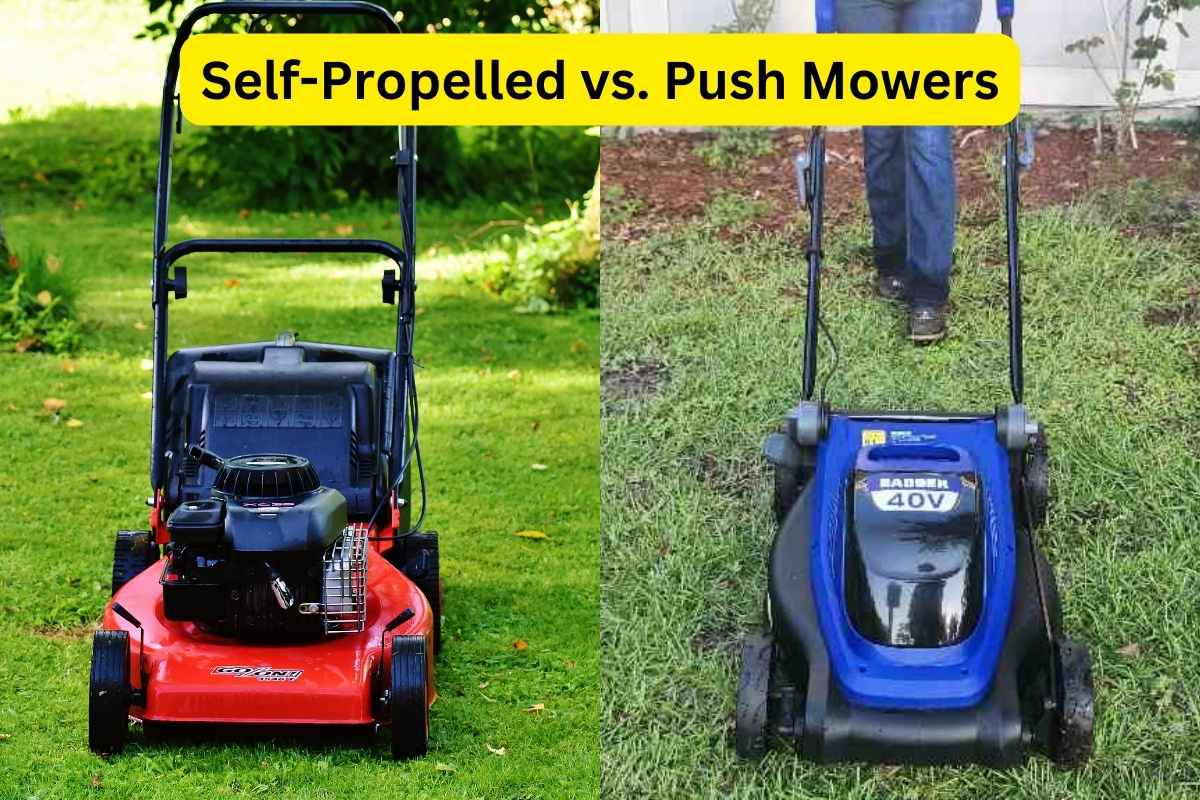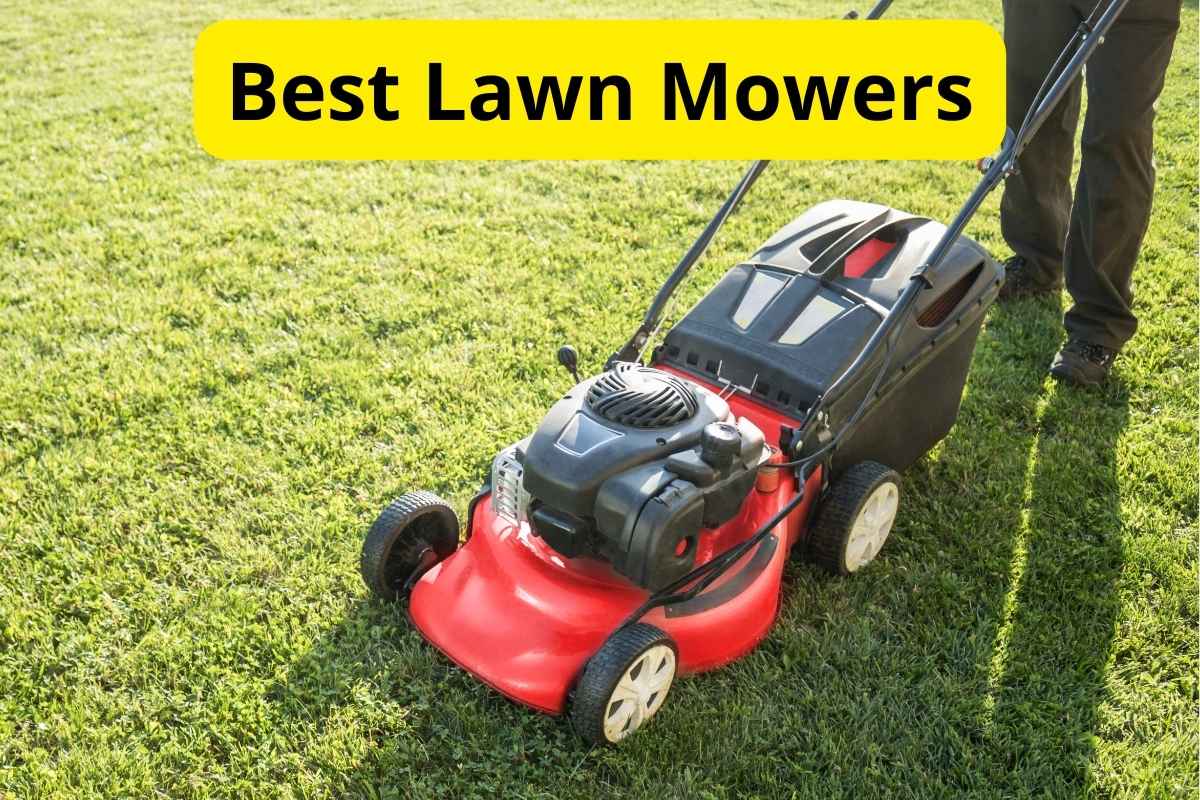
When you’re looking for a new lawn mower, your options are basically limitless, and wading through the choices on your own can feel intimidating. That’s why LawnStarter did your research for you to find the 8 best lawn mowers for the money.
No matter what size yard you have or what your budget looks like, we’ve got a mower to meet your needs. Our top picks include zero-turn mowers, lawn tractors, push mowers, gas guzzling giants, energy-efficient electric models — you name it.
We also put together a comprehensive buyers guide to help you figure out which of our best lawn mowers could be your best, too.
Top 8 Lawn Mowers – Reviews
1. Best Gas-Powered Push Mower: PowerSmart 170 cc 21-inch mower
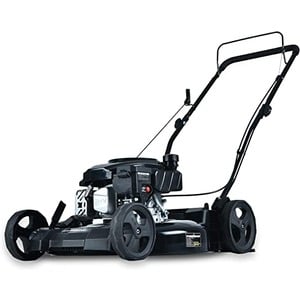
PowerSmart 170 cc 21-inch mower
At under $300, the PowerSmart DB8621CR features a strong 4-stroke engine that can power through tough overgrown lawns.
PowerSmart’s 21-inch, 170 cc mower isn’t only the most powerful gas-powered push mower on our list — it’s also the cheapest. That’s a winning combination by all accounts.
For the less than $200 price tag, you get a strong 4-stroke engine that can power through tough overgrown lawns. You also get 2-in-1 side discharging or mulching for disposing of grass clippings as you mow.
Aside from its power and price, this model from PowerSmart is our top pick because of its convenience. At less than 60 pounds, it’s lightweight and easy to push compared to other gas lawn mowers. It also folds easily for vertical storage, taking up less space in the shed or garage.
If you’re looking for a basic push mower with standard features for a typical residential lawn, you can’t go wrong with this option from PowerSmart. It represents a perfect balance between affordability, power, and ease of use.
Specifications:
- Power source: Gas
- Power level: 170 cc
- Cutting width: 21 inches
Pros:
✓ Powerful engine
✓ Lightweight
✓ Cheap
Cons:
✗ No bagging capability
✗ Some reviewers reported the handle breaking
2. Best Zero-Turn Mower: Husqvarna Z254
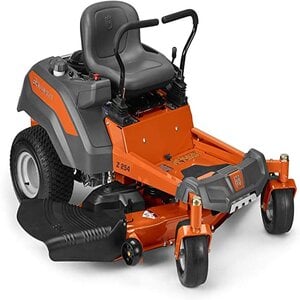
Husqvarna Z254
Husqvarna’s Z254 features a 26 HP Kohler engine and wide 54-inch cutting deck that can handle tall grass and large yards with ease.
Husqvarna is one of the industry’s most trusted brands when it comes to riding lawn mowers, and they prove why with the exceptional Z254 zero-turn mower.
This mower’s 26 HP Kohler engine and wide 54-inch cutting deck can handle tall grass and large yards with ease. The hydrostatic transmission means smooth starts and very little maintenance for you.
The Z254 costs just over $3,000, but don’t balk at the price tag. It’s actually relatively affordable compared to other zero-turn mowers, and you get loads of special features for the price.
Husqvarna’s patented park brake system is easy to use, since the brake automatically activates or deactivates as you shift the lap bars. The air induction technology for the mower deck ensures a superior cut.
The only downside to the Z254 is its speed, which caps out at 6.5 miles per hour (slow for a zero-turn). Though there are definitely faster models, 6.5 mph should be plenty of speed to finish mowing a typical yard quickly. And with all the other great things about this mower, it’s more than worth its price tag.
Specifications:
- Power source: Gas
- Power level: 26 horsepower
- Cutting width: 54 inches
Pros:
✓ Reliable, powerful Kohler engine
✓ Hydrostatic transmission
✓ Large cutting width
Cons:
✗ Slow for a zero-turn mower
✗ Mulching and bagging attachments sold separately
3. Runner-Up Zero-Turn Mower: Husqvarna MZ61
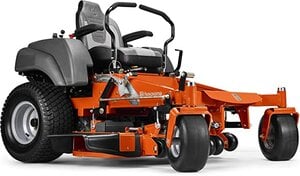
Husqvarna MZ61
Husqvarna’s MZ61 features a cushioned high-back seat, armrests, foam-padded handles, and vibration dampeners to help prevent fatigue while you mow.
If you’re considering a zero-turn mower, we assume you’ll be using it for big jobs that take hours at a time. It’s easy to wear yourself out mowing the lawn for that long, but the Husqvarna MZ61 aims to fix that.
Husqvarna designed this commercial zero-turn mower with ergonomics in mind. Its cushioned high-back seat, armrests, foam-padded handles, and vibration dampeners will help prevent fatigue while you mow.
And, of course, this is Husqvarna we’re talking about, so you can rest assured that the MZ61 has more to offer than just comfort. This mowers also has the strongest engine on our list: the 27 HP Briggs Endurance model.
This mower has the same hydrostatic transmission as the Z254, so the mower starts up easily every time. This one is significantly faster than our previous Husqvarna pick, though, with a max speed of 8.5 miles per hour.
The Husqvarna MZ61 is a premium mower with a premium price. It costs more than $5,000, the highest price tag on our list. But for that extra money, you get a high-quality machine that will make mowing your large yard easier and more comfortable.
Specifications:
- Power source: Gas
- Power level: 27 horsepower
- Cutting width: 61 inches
Pros:
✓ Reliable, powerful Briggs & Stratton engine
✓ Hydrostatic transmission
✓ Large cutting width
✓ Ergonomic seat and controls
Cons:
✗ Expensive
4. Best Self-Propelled Mower: Greenworks PRO 80V 21″ electric cordless mower
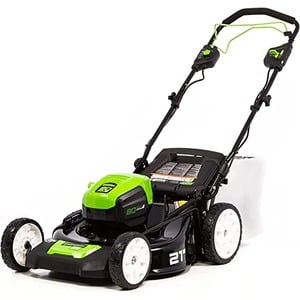
Greenworks PRO 80V 21″ electric cordless mower
Greenwork’s PRO 80V 21″ mower power rivals that of a 160 cc gas engine, but it runs much quieter and it’s easier to start.
This self-propelled mower from Greenworks runs on the brand’s 80-volt lithium-ion batteries, which are compatible with other Greenworks tools. The mower only runs for up to 45 minutes per charge, so it isn’t a great option for lawns that take more than an hour to mow.
Even though it doesn’t run as long as the Sun Joe mower, this Greenworks PRO model has a more powerful battery for tougher terrain and a wider cutting deck to reduce mowing time.
It has another major advantage, too: the self-propelled feature. Essentially, the motor pushes the mower forward for you, so all you have to do is guide it. That way, you don’t have to push the full weight of the mower with your own strength.
This mower’s power rivals that of a 160 cc gas engine, but it runs much quieter and it’s easier to start. It has 3-in-1 grass disposal like the Sun Joe model, with options for mulching, bagging, and discharging.
Specifications:
- Power source: Battery-powered electric
- Power level: 80 volts
- Cutting width: 21 inches
Pros:
✓ Self-propelled
✓ Powerful battery
✓ Battery compatible with other Greenworks tools
Cons:
✗ Battery run time less than an hour
5. Best Compact Push Mower: Greenworks 40V 14″ cordless electric mower
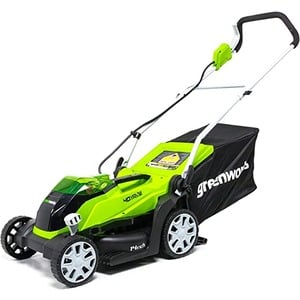
Greenworks 40V 14″ cordless electric mower
Weighing in at only 33 lbs, Greenwork’s 40V 14″ cordless electric mower is easy to store and manuever in tight places.
This smaller model from Greenworks is a great budget pick. Even though it’s battery-powered, this is one of the cheapest lawn mowers on our list at about $150.
With a 40-volt battery and 14-inch cutting width, it isn’t big or powerful enough for large yards, but it will get the job done for small lawns.
Again, just as with the 80V Greenworks model, this mower’s battery is compatible with other Greenworks tools. That means you won’t have to purchase more batteries if you buy a string trimmer, leaf blower, or other lawn care tool from the same brand. Also like our other pick from Greenworks, this mower runs for about 45 minutes on one charge.
Because the 40V mower is so small, it’s also incredibly lightweight. At only 33 pounds, it should be light enough for anyone to push. With its compact size, it’s also easy to store and maneuver in tight spaces.
Specifications:
- Power source: Battery-powered electric
- Power level: 40 volts
- Cutting width: 14 inches
Pros:
✓ Cheap
✓ Lightweight
✓ Battery compatible with other Greenworks tools
Cons:
✗ Battery run time less than an hour
✗ Small cutting width
✗ Less power than gas lawn mowers
6. Best Lawn Tractor: Husqvarna YTH24V54
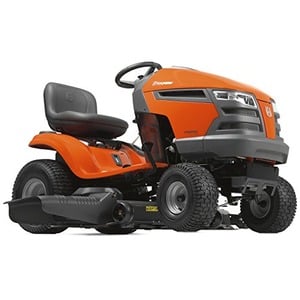
Husqvarna YTH24V54
When it comes to standard riding mowers, Husqvarna’s YTH24V54 model is the best option on the market.
Husqvarna makes our best lawn mowers list again with the YTH24V54 lawn tractor. When it comes to standard riding mowers (as opposed to zero-turns), this is the best option on the market.
Why? This mower runs on a 24 HP Briggs & Stratton V-twin engine with a hydrostatic transmission that lets you change speed and direction easily.
While it isn’t as maneuverable as zero-turn options, the YTH24V54 has a 16-inch turning radius, which is tight for a lawn tractor. It also has an electric deck engagement, which means you can conveniently activate the mower deck with a simple switch on the control panel.
The YTH24V54’s 54-inch cutting deck and speed of up to 5.5 miles per hour will help you mow a small- to medium-sized yard much faster and easier than you could with a push mower. And the adjustable high-back seat, ergonomic steering wheel, and step-through design will keep you comfortable while you do it.
Specifications:
- Power source: Gas
- Power level: 24 horsepower
- Cutting width: 54 inches
Pros:
✓ Reliable Briggs & Stratton engine with hydrostatic transmission
✓ Easy to operate
Cons:
✗ Slow compared to similar models
✗ Some reviewers had trouble with the blades clogging
7. Best Reel Mower: Scotts Outdoor 2000-20
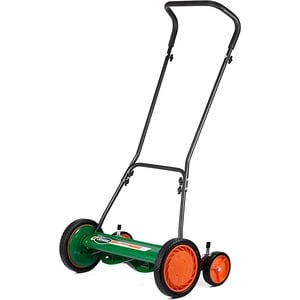
Scotts Outdoor 2000-20
For a quiet, eco-friendly mower that takes up very little storage space and requires almost no maintenance, go with the Scotts Outdoor 2000-20 reel mower.
For a small lawn that doesn’t need a big, expensive mower with a power source, a reel mower can be a solid option. The 2000-20 reel mower from Scotts Outdoor has a wide 20-inch cutting deck that will help you get through your lawn faster.
How it works: Five alloy steel rotary blades give your lawn a cleaner, healthier cut than other types of mowers (though you’ll have to work for it).
This reel mower is lightweight and inexpensive compared to the other options on this list. It’s also easy to figure out: All you have to do is push. No pull cords, no charging batteries, no storing fuel. The cushioned handle and 10-inch wheels make it easier on the user than other reel mowers, too.
For a quiet, eco-friendly mower that takes up very little storage space and requires almost no maintenance, go with the Scotts Outdoor 2000-20 reel mower. Keep in mind that mowing too large of an area with this mower will take a lot of time and effort.
Specifications:
- Power source: None
- Power level: N/A
- Cutting width: 20 inches
Pros:
✓ Large cutting width compared to other reel mowers
✓ Lightweight
✓ Maintenance-free
✓ Cheap
Cons:
✗ Takes more time and effort to push than mowers with a power source
✗ Not suitable for anything but small spaces
8. Best Electric Corded Mower: American Lawn Mower Company 50514
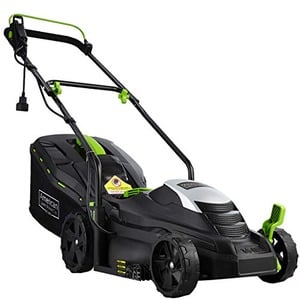
American Lawn Mower Company 50514
This corded electric lawn mower from American Lawn Mower Company is a great quiet, eco-friendly option for small yards.
This corded electric lawn mower from American Lawn Mower Company is a great quiet, eco-friendly option for small yards. It’s good for small yards only, though, since its movement is limited by the length of an extension cord and its cutting deck is only 14 inches wide.
Since this model doesn’t have to carry a battery or fuel tank, it’s extremely lightweight compared to the other push mowers on this list at only 26.5 pounds. It should be easy for anyone to push, including senior citizens and children doing chores. It’s also the most affordable mower of all our picks with a price tag just over $100.
For the price, you get a high-quality mower with an 11-amp engine that can handle most residential needs. It comes complete with a rear bagger and mulcher for disposing of grass clippings while you mow.
Specifications:
- Power source: Corded electric
- Power level: 11 amps
- Cutting width: 14 inches
Pros:
✓ Cheap
✓ Lightweight
Cons:
✗ Tethered to a cord
✗ Small cutting width
A Comprehensive Lawn Mower Buyers Guide
As you can see from the variety in our top 8 list, there are many different types of lawn mowers. You have to figure out not only which type of mower but which power source is best for your yard.
In this guide, we’ll detail the advantages and disadvantages of each category of mower. We’ll also explain how we chose our top picks and how you can use the same method to choose the top pick for you.
Push vs. self-propelled vs. riding
The first thing you have to decide is what style of lawn mower would be best for your yard. Each style has its own benefits and its own price point. Look at your budget and the size of your yard to determine what type of mower you should shop for.
Push mowers
For small- to medium-sized yards, you may want to stick with a classic push mower. Push mowers are cheaper than their self-propelled cousins and much cheaper than riding mowers.
When you’re looking at push lawn mowers, you need to consider the engine power, of course, and make sure it’s strong enough for the terrain and typical grass length in your yard.
With push mowers, you also need to consider weight. If you don’t have much upper body strength and you buy a push mower that’s 60+ pounds, you’re probably going to have a hard time using it.
More weight usually means more power, yes, but that extra power isn’t going to do you any good if your mower is too heavy for you to push around your lawn.
Self-propelled mowers
That consideration brings us to your next option: a self-propelled lawn mower. Self-propelled lawn mowers are like push mowers in many ways, but they’re easier to use.
They basically drive themselves, so you don’t have to use your own strength to push them. All you have to do is walk behind the mower and guide it where you want it to go.
Self-propelled mowers are great for people with limited strength.
Weight doesn’t matter as much as with push mowers, so you can get a more powerful (and heavier) engine without worrying about whether or not it’s too heavy for you to push.
You have to pay for such convenience, though. Self-propelled mowers are typically at least $100 more than their push mower counterparts.
Riding lawn mowers
Finally, for large yards of an acre or more, you’ll probably want to splurge on a riding lawn mower. Riding mowers can cut your mowing time significantly because they have much larger cutting widths and can mow your lawn with about half as many passes as a push lawn mower.
The best part is, you get to sit down the whole time. If you usually spend several hours mowing your lawn, a riding mower will make your life much easier.
There are two basic types of riding lawn mower: lawn tractor and zero-turn. Lawn tractors are better on hills, and they typically have more capabilities than just cutting grass. Many brands have attachments for lawn tractors such as trailers, snow plows, and seed spreaders. Lawn tractors also tend to be less expensive than zero-turns.
Zero-turn mowers cost more because they’re much easier to maneuver than lawn tractors, and they’re faster. With a zero-turn mower, you can cut down your mowing time even more than with a lawn tractor.
Zero-turns have wheels that turn at sharp angles for 180- or even 360-degree turning. They’re much easier to steer around obstacles such as trees and landscape beds. Because of their speed and easy controls, most users find them more fun to use than traditional lawn tractors.

Power sources
Once you’ve decided what style of lawn mower is best for your needs and budget, you’ll have to choose which power source you want. Each one has its share of pros and cons.
Gas: Gas lawn mowers typically have the most powerful engines. That means they can handle more difficult conditions, such as wet grass, overgrown grass and weeds, or hilly terrain.
If you’re going to use your mower for an area that typically has conditions like these, you’ll most likely want to stick with a gas engine. However, that gas engine will be loud and produce fumes, so make sure you cover your ears and maybe even wear a face mask while you mow.
Gas mowers also require more maintenance (oil changes, mixing fuel, etc.) than their electric counterparts.
Battery-powered electric: Battery-powered electric mowers (either push or riding) will almost always be more expensive and weaker than gas mowers. They’re really only suited for small- to medium-sized yards, since they’re limited by their battery’s run time.
Most battery-powered mowers only run for 30 minutes to an hour per charge, so if mowing your lawn takes longer than that, you would have to stop and recharge the battery in the middle.
There’s a significant tradeoff, though. Electric mowers run much quieter than gas engines, so they’re ideal for neighborhoods. They’re also better for the environment since they don’t produce fumes. Plus, they require far less maintenance than gas mowers.
Corded electric: Corded electric mowers are usually the cheapest option. They’re eco-friendly and quiet, just like battery-powered mowers, but they don’t have the same time limit. Instead, they have restricted movement since they have to stay plugged into an outlet.
If you need to mow an area out of reach of an extension cord, a corded electric mower won’t be an option for you. They’re great for small lawns, though, because they’re affordable, lightweight, and usually compact.
Reel: Reel mowers are old school. They don’t have a power source at all. As you push the mower, you manually make the blades turn. Of course, that means you’ll have to work harder to push a reel mower.
The extra work might be worth it to you for several reasons. First of all, the way reel mowers cut is healthier for your grass than the blades of other mowers.
Plus, reel mowers are lightweight compared to others, and they’re the most truly eco-friendly option, since they don’t use gas or electricity.
Typically, you wouldn’t use a reel mower for anything larger than a small lawn or side yard (unless you’re willing to put in a whole lot of effort).

How we chose our top picks (and how to choose yours)
To figure which lawn mowers are the best on the market right now, we compared factors such as engine power, cutting width, and most importantly, price.
The result is a list of mowers that pack the most bang for your buck. But how do you know what balance of power, size, and affordability is best for you? Let’s discuss.
Power: Do you need to pay for extra power? Think about the area you’ll be mowing. Do you often let your grass grow long? Do you cut wet grass frequently? Does your property have a lot of inclines?
In any of these cases, you will most likely need a more powerful mower. On the other hand, if you have a flat lawn with usually short grass, you’ll probably be fine with less power and won’t need to spend the extra money.
Cutting width: How big is your lawn? How much time do you want to spend mowing it? Your answers to these questions determine what cutting width your mower needs.
Cutting width describes how much of your lawn the mower can cover in a single pass.
With a small push mower that’s 14 inches wide, for instance, you’ll have to make a lot more passes and spend more time mowing than you would with a large riding mower that’s 60 inches wide.
This is why we recommend a riding mower for large properties.
Price: As you’ve seen, there is a lawn mower for every budget. Some are barely $100, while others cost $5,000 or more.
You’ll usually pay more for mowers that are larger and more powerful. You’ll also pay more for special features such as a rear bagging function or easy start technology.
Consider your lawn’s specific needs and decide how much you’re willing to pay to make mowing easier and faster. The budget you decide on will narrow down your options significantly.
FAQ About Lawn Mowers
1. What time of year is best for buying a lawn mower?
Lawn mowers are usually at their lowest prices after the mowing season but before winter, in September or October. However, keep in mind that if you buy in the fall, you won’t be able to use your mower and test how it works on your lawn for several months.
2. What size lawn mower do I need?
For a typical residential lawn, a push mower with around a 20-inch deck should meet your needs. For properties of an acre or more, we recommend a riding lawn mower, most of which are at least 54 inches wide.
3. What is the easiest lawn mower to use?
Electric self-propelled lawn mowers, like the Greenworks PRO 80V mower on our list, are the easiest to use because they have a push-button start and you don’t have to push them.
When it comes to riding lawn mowers, zero-turns are easier to maneuver, but lawn tractors have a more familiar steering wheel instead of lap bars, which can be difficult to get used to.
Conclusion
Remember: Every yard is different. The best lawn mower for you might not be the best lawn mower for your neighbor. That being said, the 10 mowers on this list are some of the best options on the market. Hopefully, we helped you find what you need, for a price you’re happy with.
And maybe the best lawn mower for you isn’t a power tool but a lawn mowing service that will do all the work for you. That way, you won’t have to worry about buying (or using) a lawn mower at all.
LawnStarter participates in the Amazon Services LLC Associates Program and other retailer affiliate programs. LawnStarter may earn revenue from products promoted in this article.
Main Image Credit: Dony / Canva Pro / License wih Text Overlay using Canva Pro
![7 Best Gas Lawn Mowers of 2025 [Reviews] person usiing lawn mower with text overlay on it](https://www.lawnstarter.com/blog/wp-content/uploads/2021/07/Best-Gas-Lawn-Mowers.jpg)
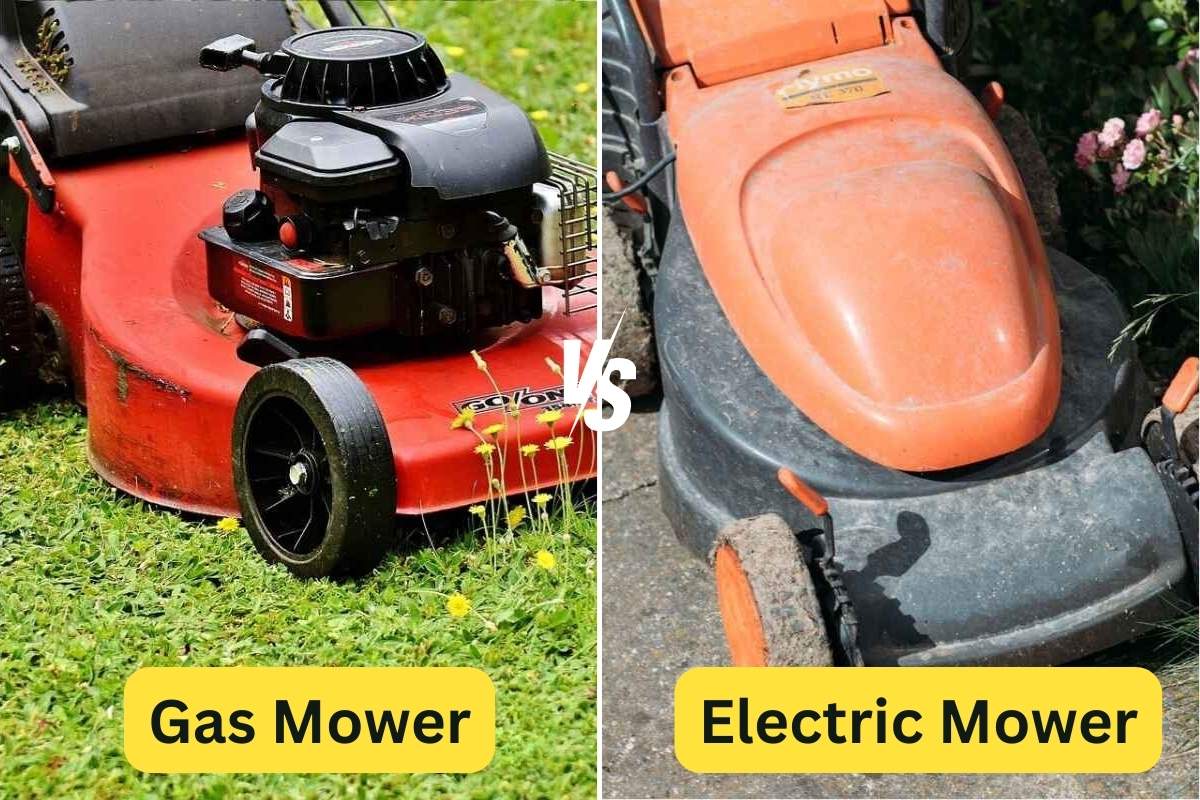
![9 Best Push Lawn Mowers of 2025 [Reviews] push lawn mower in a yard with text overlay on it](https://www.lawnstarter.com/blog/wp-content/uploads/2023/11/Best-Push-Lawn-Mowers.jpg)
![10 Best Lawn Mowers for Small Yards in 2025 [Reviews] lawn mower cutting grass of small yards with text overlay on it](https://www.lawnstarter.com/blog/wp-content/uploads/2021/01/Best-Lawn-Mowers-for-Small-Yards.jpg)
